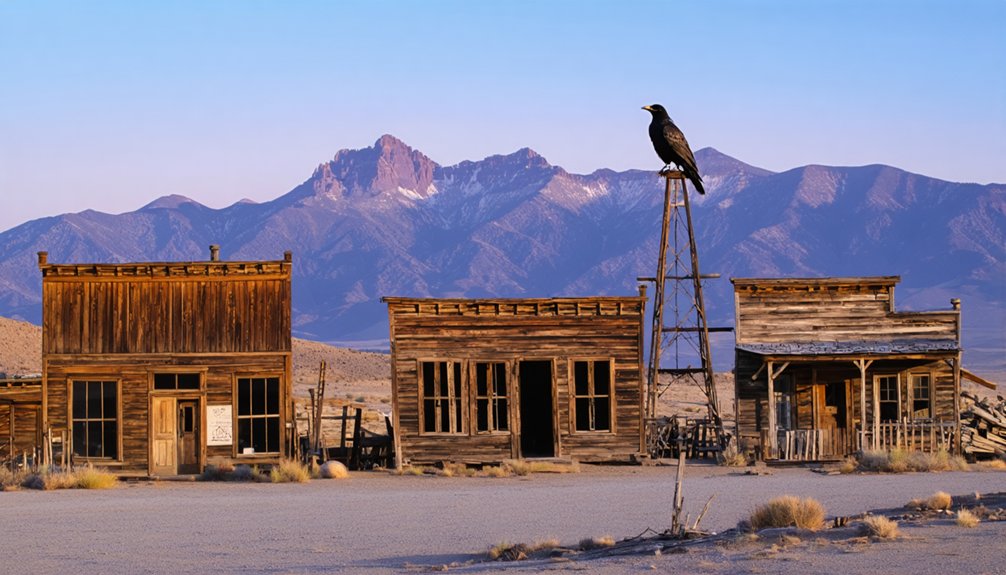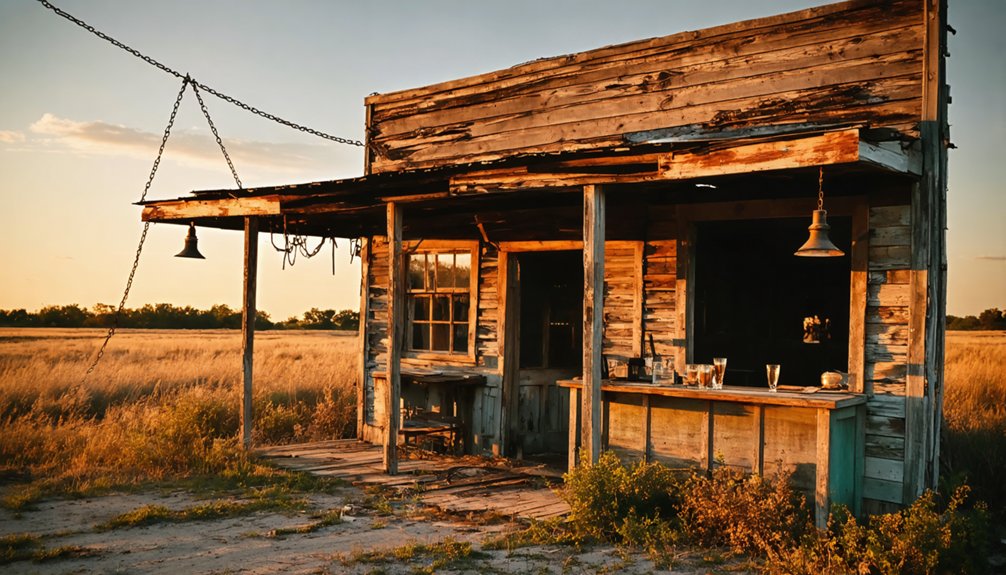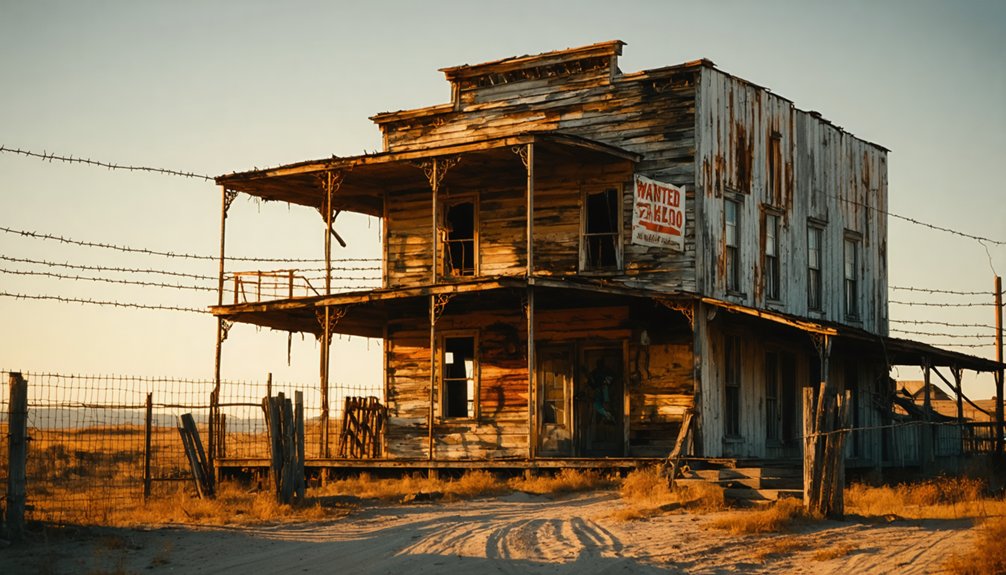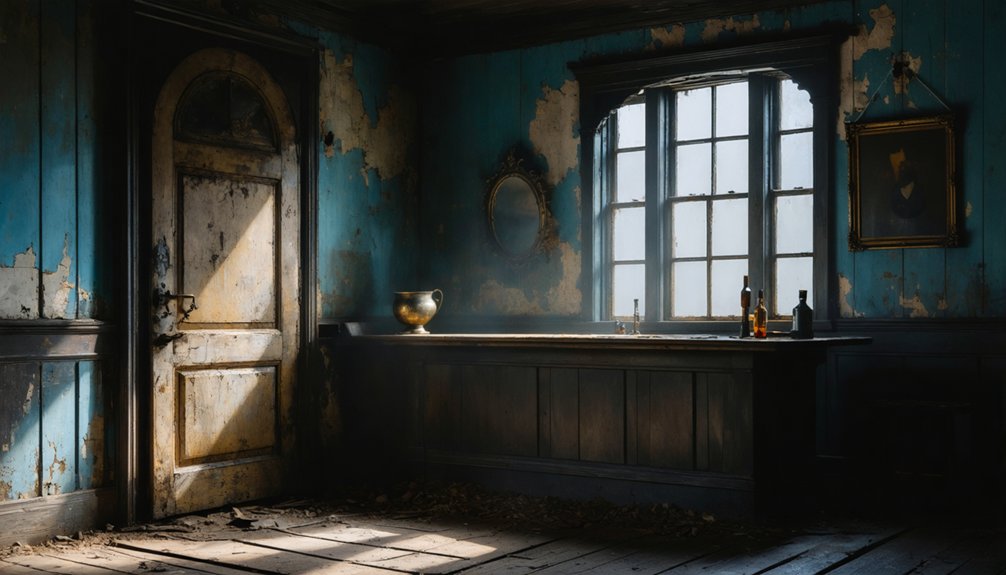California’s most impressive historic ghost towns include Bodie State Historic Park, preserved in “arrested decay” with 110 original structures from its 1880s gold rush peak; Calico Ghost Town, Walter Knott’s restored silver mining settlement featuring interactive mine tours; and Cerro Gordo Mines, once California’s largest silver producer that helped build Los Angeles. You’ll find authentic mining equipment, period architecture, and glimpses into frontier life across these remarkable time capsules of Western expansion.
Key Takeaways
- Bodie State Historic Park preserves 110 structures in “arrested decay,” offering the most authentic ghost town experience in California.
- Calico Ghost Town features restored silver mining buildings, the Zenda Mining Museum, and interactive experiences like mine shaft tours.
- Cerro Gordo Mines, once California’s largest silver producer, showcases mining history that significantly contributed to Los Angeles’ development.
- Each town represents different mineral rushes—Bodie (gold), Calico (silver), and Cerro Gordo (silver/lead)—with distinct architectural styles.
- Visitors can experience California’s mining heritage through preserved buildings, exhibits, and tours at all three historically significant ghost towns.
Bodie State Historic Park: A Frozen-in-Time Mining Settlement
Nestled among the barren hills of California’s Eastern Sierra, Bodie State Historic Park stands as America’s most authentic and well-preserved ghost town, offering visitors a genuine glimpse into the boom-and-bust cycle of Western mining communities.
Following William S. Bodey’s 1859 gold discovery, this settlement exploded into a thriving boomtown of 7,000-10,000 residents by 1880, with distinctive Bodie architecture spanning 2,000 buildings from simple miners’ cabins to elaborate banks. The town’s miners earned approximately $4 per day while working in dangerous conditions to extract gold from the quartz ore.
From humble shacks to grand financial institutions, Bodie’s 2,000 structures housed a gold-fueled population explosion within just two decades.
The town’s meteoric rise ended after devastating fires and the 1942 presidential order halting gold mining operations.
Today, preserved in “arrested decay,” you’ll find 110 historic structures exactly as residents left them. Walking among these weathered remnants of Gold Rush aspirations, you’re experiencing one of America’s most significant mining-era landscapes. The notorious reputation of lawlessness earned Bodie the title of “bad man of Bodie” where violence and crime flourished alongside gold mining operations.
Calico Ghost Town: Silver Rush Preserved in the Desert
While Bodie captures the golden dreams of the Sierra, another remarkable ghost town awaits in California’s Mojave Desert. Founded in 1881 during one of California’s largest silver strikes, Calico’s multi-colored mountains yielded over $20 million in silver before prices crashed in the mid-1890s.
Calico history took a preservation turn when Walter Knott purchased and restored the abandoned town in the 1950s. Now a living museum and State Historical Landmark #782, you’ll discover architecturally restored buildings and the Zenda Mining Museum showcasing authentic mining artifacts.
You can explore the town’s 500-mine legacy via an 8-minute train ride and walking tours through restored mine shafts. For an authentic glimpse into mining life, visitors can tour Maggie’s Mine with mannequins depicting miners working in the silver mines. Beyond the main attractions, visitors should venture to discover the remnants of the historic Chinatown District that once thrived during Calico’s heyday.
Unlike many forgotten settlements, Calico thrives as California’s official Silver Rush Ghost Town, preserving the boom-and-bust narrative of America’s mining past.
Cerro Gordo Mines: Hidden Mountain Treasures of the Old West
High in the Inyo Mountains of Eastern California, Cerro Gordo stands as one of the state’s most significant yet overlooked mining settlements. Discovered in 1865, this silver-rich outpost quickly changed from a Mexican prospecting site into California’s largest producer of silver and lead by 1869, generating nearly $500 million in minerals throughout its history.
When you explore Cerro Gordo history, you’ll discover:
- The town’s economic impact extended beyond its borders, with early trade substantially contributing to Los Angeles’ growth and development. Pablo Flores first found silver and lead on what would become Cerro Gordo’s Buena Vista Peak, starting a rush that transformed the region. At its peak, the boomtown housed 4,000 residents with numerous amenities including saloons and brothels.
- Advanced mining techniques evolved from simple extraction methods to sophisticated operations shipping 1,000 tons of ore daily during the zinc boom.
- The settlement experienced multiple revivals, shifting from silver to zinc production before its final commercial closure in 1957.
Frequently Asked Questions
Are These Ghost Towns Actually Haunted?
You’re chasing ghost stories in decaying relics! While paranormal experiences are widely reported, these hauntings remain scientifically unverified—mostly anecdotal evidence and local legends amplified through tourism and historical trauma narratives.
Can I Legally Collect Artifacts From These Historic Sites?
No, you can’t legally collect artifacts. California’s strict laws protect these sites for everyone’s benefit. Artifact collection laws prohibit removal, while site preservation ethics emphasize experiencing history without diminishing it for others.
Which Ghost Town Is Most Suitable for Children?
Like a frontier playground where history’s dust settles gently, Calico Ghost Town offers the most kid-safe explorations with its interactive museum, optical illusions, gold panning, and train rides—perfect for your family friendly activities throughout the day.
What Survival Supplies Should I Bring to Remote Locations?
You’ll need water purification tools, high-calorie rations, emergency gear like first aid kits, navigation tools (maps/compass), shelter options, appropriate clothing, signaling devices, and multi-tools for remote explorations.
Do Any Ghost Towns Offer Overnight Accommodation Options?
Like time capsules awaiting exploration, several ghost towns offer overnight accommodations. You’ll find lodging at Calico (cabins), Pioneertown (motel), and St. Elmo (guest house), while others provide nearby options for overnight ghost tours.
References
- https://nightofthejack.com/2024/04/22/must-see-ghost-towns-in-california/
- https://theatlasheart.com/ghost-towns-in-california/
- https://whimsysoul.com/must-see-california-ghost-towns-explore-forgotten-histories/
- https://californiacrossings.com/best-ghost-towns-in-california/
- https://www.visitcalifornia.com/road-trips/ghost-towns/
- https://enjoyorangecounty.com/california-ghost-towns/
- https://www.christywanders.com/2024/08/top-ghost-towns-for-history-buffs.html
- https://dot.ca.gov/-/media/dot-media/programs/environmental-analysis/documents/ser/townsites-a11y.pdf
- https://www.tripadvisor.com/Attractions-g28926-Activities-c47-t14-California.html
- https://www.camp-california.com/california-ghost-towns/



